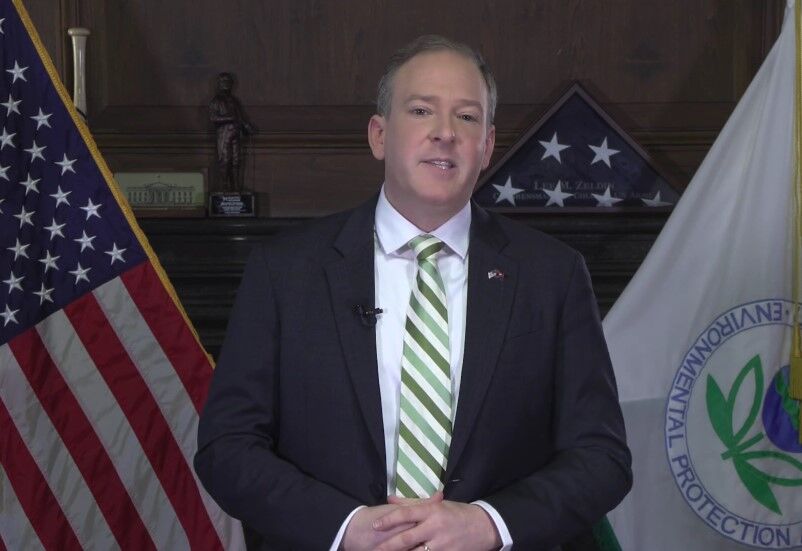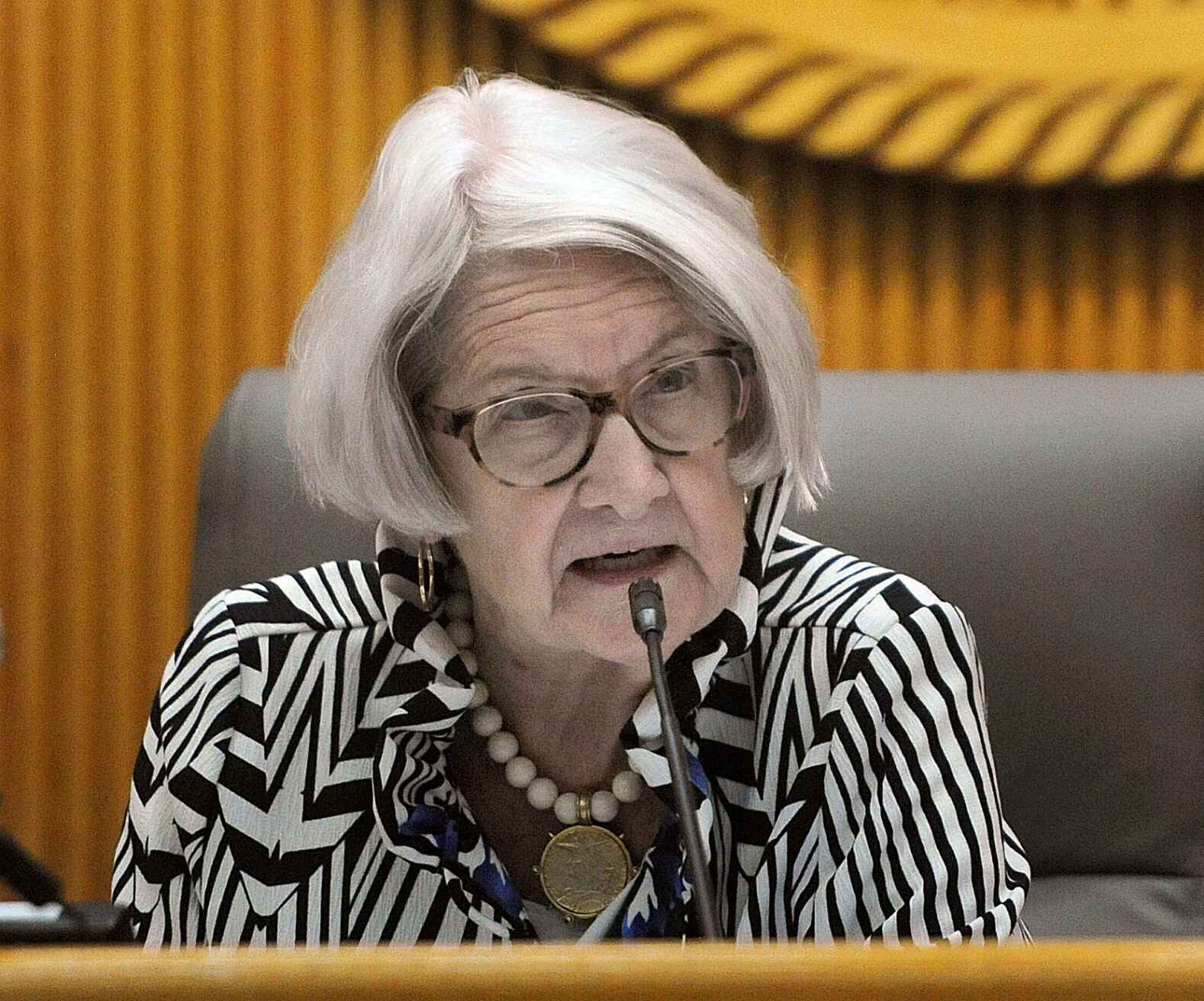A new, dark cloud hangs over rooftop solar development in West Virginia.
It might also be illegal.
The dark cloud is the Trump administration’s announcement Thursday that it is terminating a program which the U.S. Environmental Protection Agency last year selected the West Virginia Office of Energy to receive $106.1 million to deliver solar power to low-income and disadvantaged residents.
The award was expected to lower residential energy bills for West Virginia consumers and was one of 49 state-level awards the EPA had announced under the Biden administration in April 2024 through the Solar for All program totaling $5.5 billion. Eleven more awards to serve multistate recipients and tribes totaled another $1.5 billion.

U.S. Environmental Protection Agency Administrator Lee Zeldin
announces plans to roll back a wide range of environmental
regulations in a video the agency published March 12, 2025.
mtony / Environmental Protection Agency | Courtesy photo
But EPA Administrator Lee Zeldin on Thursday claimed his agency no longer has authority to administer the program — despite funds having been obligated under binding agreements.
Chelsea Morrison, West Virginia Office of Energy communications manager, said Friday the Office of Energy received a termination notice from the EPA.
Two days earlier, Morrison said the office’s financial team has been drawing down portions of its Solar for All funding as needed to support program planning, staffing and other program-related expenses. Morrison said that because of the drawdown structure, she couldn’t provide the total amount of funds used to date.
The Solar for All cancellation, likely to be challenged in court, is one of many Trump administration moves designed to choke off supply of renewable energy regarded as a source of more affordable energy – especially in West Virginia, where electricity prices have increased sharply amid the state’s nation-highest dependence on increasingly uneconomic coal-fired power.
Dana Kuhnline, program manager at ReImagine Appalachia, a regional coalition of economic and environmental leaders, condemned the EPA’s move to terminate Solar for All as a “senseless action” in a statement.
“Solar for All is one of the few federal programs left that can help Americans lower their electricity bills,” Kuhnline said. “Appalachian communities have been hard hit by the downturn of the coal industry and rising electric bills.”
Kuhnline estimated Solar for All clawbacks would prevent the installation of solar on more than 150,000 households in low-income and disadvantaged communities in the region, blocking programs in West Virginia, Kentucky, Ohio, Pennsylvania and Virginia that would have saved Appalachian low-income households over $70 million on their utility bills.
“Solar for All is a practical program that could create real relief for households across the region,” Kuhnline said.
The EPA’s Solar for All termination fits with the agency’s proposal to cast scientific consensus aside to undo its 2009 finding that greenhouse gases threaten public health, contradicting wide, longstanding agreement among climate scientists that extreme weather events have become more common, driven by climate change rooted in increased greenhouse gas emissions.
That EPA proposal, announced July 29, was in line with the agency’s plan released in June to hold that greenhouse gas emissions don’t contribute significantly to dangerous air pollution, a proposed finding it has paired with a plan to repeal all greenhouse gas emissions standards for fossil fuel-fired power plants under Section 111 of the Clean Air Act. That law has governed such emissions from fossil fuel-fired electric generating units for decades.
The EPA’s proposed determination that greenhouse gas emissions don’t contribute significantly to dangerous air pollution is undermined by the agency’s own analysis of its plan to repeal all greenhouse gas emissions for fossil fuel-fired power.
That analysis, released in a Regulatory Impact Analysis document, found that the plan would result in up to 78 fewer ozone-related premature deaths avoided and up to 570 fewer fine particulate matter-related premature deaths avoided in 2028 alone — totals projected to more than double in 2035.
The analysis also projected the plan would result in net costs totaling dozens of billions of dollars, thousands fewer jobs and reduced investment in electricity.
PSC downplays climate dangers
But the West Virginia Public Service Commission addressed formal comments to the EPA Thursday supporting the EPA’s proposal to repeal greenhouse gas standards for fossil fuel-fired plants, claiming without evidence that greenhouse gases don’t significantly contribute to dangerous air pollution.
The PSC used the phrase “litany of assumptions” to characterize scientific consensus-supported observations that carbon dioxide is a greenhouse gas, greenhouse gases contribute to global warming and global warming may lead to changes in weather patterns.
The PSC contended that U.S. fossil fuel power plants “control a de minimis contribution” of carbon dioxide emissions, a year after the Biden-era EPA projected up to $370 billion in net climate and public health benefits over the next two decades from its rule finalized last year to strengthen pollution standards for new gas and existing coal power plants.
If the U.S. power sector were a country, it would have been the sixth-largest emitter in the world in 2022, polluting more than Brazil and Japan, according to a paper published in May 2025 by the Institute for Policy Integrity at New York University School of Law.

Public Service Commission Chairman Charlotte Lane is shown
during a June 17, 2025 hearing at the PSC headquarters in
Charleston.
CHRISTOPHER MILLETTE | Gazette-Mail file photo
PSC Chairwoman Charlotte Lane, a former lobbyist of coal-fired plant controller FirstEnergy, is a vocal coal industry supporter. Fellow PSC member Bill Raney is a longtime former president of the West Virginia Coal Association. Both were appointed to the PSC by Sen. Jim Justice, R-W.Va., a coal magnate, when he was governor. Lane previously served on the PSC from 1985 to 1989 and 1997 to 2003.
As the EPA and PSC downplay established climate science to protect the coal industry, West Virginia consumers are at risk of bearing a heavy cost burden.
“Breaking this promise is not only short-sighted — it would keep nearly a million American families trapped in an impossible choice each month of whether to pay for food, buy medicine, or keep the lights on,” Rev. Jessica Moerman, president and CEO of the Evangelical Environmental Network, a national Christian environmental advocacy group, said in a statement.
Solar for All slated to cover 900K+ households
Moerman’s prediction Solar for All would have that impact on nearly a million U.S. families followed an announcement last year from then-EPA Administrator Michael Regan the EPA’s $7 billion investment in solar energy projects would cover over 900,000 households in low-income and disadvantaged communities.
In April 2024, the EPA said the West Virginia Office of Energy would use Solar for All funding to deploy residential solar roofs, support home energy efficiency and reduce utility costs for low-income residents.
At the time, the EPA said a West Virginia REAL Energy Resilient Roofs Program would reach low-income and disadvantaged residents across West Virginia to deliver solar to residents, communities and college housing, with support from over a dozen organizations, cities and community stakeholders.
Greenhouse gases kill. The United States is one of the world’s most prolific polluters of them.
The EPA said Solar for All would mobilize financing and private capital to create jobs, lower greenhouse gas emissions and reduce electricity bills for the state’s most underserved homeowners.
Morrison on Wednesday said the West Virginia Office of Energy had access to its Solar for All award and remained in the program’s planning phase. Construction efforts wouldn’t start until the program’s implementation phase, so no physical projects have begun, Morrison said.
The Office of Energy previously said it would launch the Solar for All program in 2026, when interested homeowners could complete an online application to determine their eligibility for receiving free or reduced-cost solar panels for their home.
Interested solar industry contractors would have the option to participate in a screening exercise to review business qualifications and quality of work, the Office of Energy had said.
Nationwide, 90% of Solar for All grant recipients planned to fund residential rooftop solar, the EPA had said.
Solar advocates say more sun power will mean lighter energy burdens for underprivileged West Virginians. There’s evidence of racial and ethnic disparities in solar benefits.
A new study by Stanford University researchers found about 60% of U.S. families could reduce their electricity costs by 15% on average by installing rooftop solar and battery packs. Published last week by the peer-reviewed scientific journal Nature Energy, the study found 63% of households could achieve affordable backup power during power outages covering an average of 51% of their essential energy needs.
“With electricity rates now rising in most states, shaving utility bills can help people quite a bit, but the ability to ride out local or regional blackouts is becoming very important to many families,” the study’s senior author, Stanford associate professor of civil and environmental engineering and of electrical engineering Ram Rajagopal said in a news release.
But a residential clean energy tax credit approved by a Democratic-controlled Congress through the Inflation Reduction Act in 2022 were curtailed by the Republican One Big Beautiful Bill Act signed into law by President Donald Trump last month.
The latter law terminated that credit effective Dec. 31, 2025, hastening an end to the credit offering a 30% credit for taxpayer expenses that included uncapped credit amounts for solar panels, battery storage technology and solar water heaters.
‘We will see them in court’
Zeldin claimed Thursday the EPA had no authority to administer Solar for All, which he called a “boondoggle,” because of the One Big Beautiful Bill Act. Zeldin noted the law repealed the Greenhouse Gas Reduction Fund enacted through the Inflation Reduction Act that appropriated $27 billion to the EPA to enable low-income communities to benefit from zero-emission technologies. Solar for All was housed under the Greenhouse Gas Reduction Fund.
Solar proponents and other legal advocates say the EPA can’t legally rescind money it has obligated. The Trump administration has already gone after Greenhouse Gas Reduction Fund appropriations, freezing grants through the program earlier this year.
“If leaders in the Trump administration move forward with this unlawful attempt to strip critical funding from communities across the United States, we will see them in court,” Kym Meyer, litigation director at Southern Environmental Law Center, an environmental law group, said in a statement.
Thursday was a black day for green energy in America.
Sen. Bernie Sanders, I-Vt., who provided the legislation resulting in the Solar for All program, contended the Trump administration’s move to kill the program was illegal.
“At a time when working families are getting crushed by skyrocketing energy costs and the planet is literally burning, sabotaging this program isn’t just wrong — it’s absolutely insane,” Sanders said in a statement.
Rooftop solar drop projected due to GOP reconciliation law
Rooftop solar costs significantly more in the U.S. than in other countries, driven up by more daunting permitting and interconnection procedures.
Republican-led attacks on federal residential solar incentives are poised to drag forward that status quo.
Americans are expected to install 26% less residential solar in 2026 than if the residential clean energy credit hadn’t been removed, according to an analysis by Ohm Analytics, a national clean energy data and research company.
Rep. Riley Moore, R-W.Va., who voted along with the rest of West Virginia’s congressional delegation to repeal the Greenhouse Gas Reduction Fund through the One Big Beautiful Bill Act, signaled support for the EPA’s Solar for All termination Thursday.
Moore posted an emoji depicting raised hands with the word “Yes” in a X post sharing Zeldin’s termination announcement.
Lane and a PSC spokesperson didn’t respond to a request for comment on the EPA’s move to terminate Solar for All on Friday.
“Solar for All,” ReImagine Appalachia’s Kuhnline said, “is a practical program that could create real relief for households across the region.”

